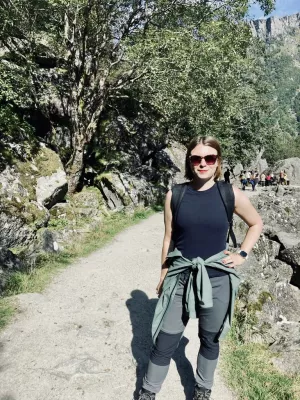
Kristin Doering
Forskare

Factors controlling plankton community production, export flux, and particulate matter stoichiometry in the coastal upwelling system off Peru
Författare
Summary, in English
Eastern boundary upwelling systems (EBUS) are among the most productive marine ecosystems on Earth. The production of organic material is fueled by upwelling of nutrient-rich deep waters and high incident light at the sea surface. However, biotic and abiotic factors can modify surface production and related biogeochemical processes. Determining these factors is important because EBUS are considered hotspots of climate change, and reliable predictions of their future functioning requires understanding of the mechanisms driving the biogeochemical cycles therein. In this field experiment, we used in situ mesocosms as tools to improve our mechanistic understanding of processes controlling organic matter cycling in the coastal Peruvian upwelling system. Eight mesocosms, each with a volume of ∼ 55 m3, were deployed for 50 d ∼ 6 km off Callao (12◦ S) during austral summer 2017, coinciding with a coastal El Niño phase. After mesocosm deployment, we collected subsurface waters at two different locations in the regional oxygen minimum zone (OMZ) and injected these into four mesocosms (mixing ratio ≈ 1.5: 1 mesocosm: OMZ water). The focus of this paper is on temporal developments of organic matter production, export, and stoichiometry in the individual mesocosms. The mesocosm phytoplankton communities were initially dominated by diatoms but shifted towards a pronounced dominance of the mixotrophic dinoflagellate (Akashiwo sanguinea) when inorganic nitrogen was exhausted in surface layers. The community shift coincided with a short-term increase in production during the A. sanguinea bloom, which left a pronounced imprint on organic matter C: N: P stoichiometry. However, C, N, and P export fluxes did not increase because A. sanguinea persisted in the water column and did not sink out during the experiment. Accordingly, export fluxes during the study were decoupled from surface production and sustained by the remaining plankton community. Overall, biogeochemical pools and fluxes were surprisingly constant for most of the experiment. We explain this constancy by light limitation through self-shading by phytoplankton and by inorganic nitrogen limitation which constrained phytoplankton growth. Thus, gain and loss processes remained balanced and there were few opportunities for blooms, which represents an event where the system becomes unbalanced. Overall, our mesocosm study revealed some key links between ecological and biogeochemical processes for one of the most economically important regions in the oceans.
Publiceringsår
2020-10-12
Språk
Engelska
Sidor
4831-4852
Publikation/Tidskrift/Serie
Biogeosciences
Volym
17
Issue
19
Dokumenttyp
Artikel i tidskrift
Förlag
Copernicus GmbH
Ämne
- Oceanography, Hydrology, Water Resources
Aktiv
Published
ISBN/ISSN/Övrigt
- ISSN: 1726-4170

